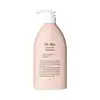What's inside
What's inside
 Key Ingredients
Key Ingredients

 Benefits
Benefits

 Concerns
Concerns

 Ingredients Side-by-side
Ingredients Side-by-side

Water
Skin ConditioningCocamidopropyl Hydroxysultaine
CleansingDisodium Laureth Sulfosuccinate
CleansingSodium C14-16 Olefin Sulfonate
CleansingGlycerin
HumectantSodium Chloride
MaskingDipropylene Glycol
HumectantHydroxyacetophenone
AntioxidantCaprylyl Glycol
EmollientPolyquaternium-10
Prunus Amygdalus Amara Kernel Oil
MaskingHaematococcus Pluvialis Extract
AntioxidantCamellia Sinensis Leaf Extract
AntimicrobialSodium Cocoyl Alaninate
Citric Acid
BufferingPyrus Malus Leaf Extract
Skin ConditioningTetradecene
EmollientHexadecene
SolventDisodium EDTA
Vanilla Planifolia Fruit Extract
Skin ConditioningJasminum Officinale Flower Water
MaskingButylene Glycol
HumectantEthylhexylglycerin
Skin Conditioning1,2-Hexanediol
Skin ConditioningRosa Centifolia Flower Water
Skin ConditioningSodium Hyaluronate
HumectantDipotassium Glycyrrhizate
HumectantEriobotrya Japonica Leaf Extract
Skin ConditioningMorus Alba Leaf Extract
Skin ConditioningLeonurus Sibiricus Extract
Skin ConditioningWater, Cocamidopropyl Hydroxysultaine, Disodium Laureth Sulfosuccinate, Sodium C14-16 Olefin Sulfonate, Glycerin, Sodium Chloride, Dipropylene Glycol, Hydroxyacetophenone, Caprylyl Glycol, Polyquaternium-10, Prunus Amygdalus Amara Kernel Oil, Haematococcus Pluvialis Extract, Camellia Sinensis Leaf Extract, Sodium Cocoyl Alaninate, Citric Acid, Pyrus Malus Leaf Extract, Tetradecene, Hexadecene, Disodium EDTA, Vanilla Planifolia Fruit Extract, Jasminum Officinale Flower Water, Butylene Glycol, Ethylhexylglycerin, 1,2-Hexanediol, Rosa Centifolia Flower Water, Sodium Hyaluronate, Dipotassium Glycyrrhizate, Eriobotrya Japonica Leaf Extract, Morus Alba Leaf Extract, Leonurus Sibiricus Extract
Water
Skin ConditioningSorbitol
HumectantCocamidopropyl Betaine
CleansingLauryl Glucoside
CleansingGlycerin
HumectantPanthenol
Skin ConditioningCoco-Glucoside
CleansingGlyceryl Oleate
EmollientAcrylates/C10-30 Alkyl Acrylate Crosspolymer
Emulsion StabilisingAloe Barbadensis Leaf Juice Powder
Skin ConditioningChamomilla Recutita Flower Extract
MaskingCitric Acid
BufferingHeliotropine
MaskingHydrogenated Palm Glycerides Citrate
EmollientHydrolyzed Wheat Protein
Skin ConditioningParfum
MaskingSodium Hydroxide
BufferingTocopherol
AntioxidantZinc Sulfate
AntimicrobialWater, Sorbitol, Cocamidopropyl Betaine, Lauryl Glucoside, Glycerin, Panthenol, Coco-Glucoside, Glyceryl Oleate, Acrylates/C10-30 Alkyl Acrylate Crosspolymer, Aloe Barbadensis Leaf Juice Powder, Chamomilla Recutita Flower Extract, Citric Acid, Heliotropine, Hydrogenated Palm Glycerides Citrate, Hydrolyzed Wheat Protein, Parfum, Sodium Hydroxide, Tocopherol, Zinc Sulfate
Ingredients Explained
These ingredients are found in both products.
Ingredients higher up in an ingredient list are typically present in a larger amount.
Citric Acid is an alpha hydroxy acid (AHA) naturally found in citrus fruits like oranges, lemons, and limes.
Like other AHAs, citric acid can exfoliate skin by breaking down the bonds that hold dead skin cells together. This helps reveal smoother and brighter skin underneath.
However, this exfoliating effect only happens at high concentrations (20%) which can be hard to find in cosmetic products.
Due to this, citric acid is usually included in small amounts as a pH adjuster. This helps keep products slightly more acidic and compatible with skin's natural pH.
In skincare formulas, citric acid can:
While it can provide some skin benefits, research shows lactic acid and glycolic acid are generally more effective and less irritating exfoliants.
Most citric acid used in skincare today is made by fermenting sugars (usually from molasses). This synthetic version is identical to the natural citrus form but easier to stabilize and use in formulations.
Read more about some other popular AHA's here:
Learn more about Citric AcidGlycerin is already naturally found in your skin. It helps moisturize and protect your skin.
A study from 2016 found glycerin to be more effective as a humectant than AHAs and hyaluronic acid.
As a humectant, it helps the skin stay hydrated by pulling moisture to your skin. The low molecular weight of glycerin allows it to pull moisture into the deeper layers of your skin.
Hydrated skin improves your skin barrier; Your skin barrier helps protect against irritants and bacteria.
Glycerin has also been found to have antimicrobial and antiviral properties. Due to these properties, glycerin is often used in wound and burn treatments.
In cosmetics, glycerin is usually derived from plants such as soybean or palm. However, it can also be sourced from animals, such as tallow or animal fat.
This ingredient is organic, colorless, odorless, and non-toxic.
Glycerin is the name for this ingredient in American English. British English uses Glycerol/Glycerine.
Learn more about GlycerinWater. It's the most common cosmetic ingredient of all. You'll usually see it at the top of ingredient lists, meaning that it makes up the largest part of the product.
So why is it so popular? Water most often acts as a solvent - this means that it helps dissolve other ingredients into the formulation.
You'll also recognize water as that liquid we all need to stay alive. If you see this, drink a glass of water. Stay hydrated!
Learn more about Water